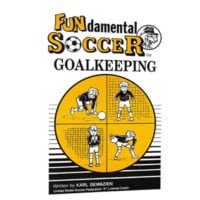U-12+ Game
U-12 Laws of the Game
“The world’s top clubs are already utilizing small-sided games to develop more technical players in their youth programs, an approach that we here in America are slow to adopt.
“It all starts with the proper numbers of players at training and games for the specific age group at practice. The youth academies in Spain such as Barcelona, Real Madrid, and Atletico Madrid play games with player numbers no larger than 7v7 up to 12 years old.
“The size of the field is smaller, and the ball is smaller so that the players can function according to their physical abilities. They have understood that the players are not yet adults.”
Stan Baker
Author, Our Competition is the World
Have you heard?
There is a SocceRevolution happening!
Follow FIFA Laws of the Game* Except for These Modifications
- KARLS DEWAZIEN 1980
FIELD OF PLAY
Law 1
The field of play shall be rectangular.
Its length should not be more than 110 yards (minimum 70 yards) and its width, not more than 60 yards (minimum 40 yards).
The length in all cases should exceed the width.
Markings
- Lines: Distinctive (at least 2-5 inches wide)
- Halfway Line: Marked out across the field
- Center Circle: Over Halfway Line with a 10-yard radius
- Corner Arcs: Four (4) arcs, each with a 1-yard radius
- Goal Area: Six (6) yards from each goal post and six (6) yards into the field of play, then joined by a line drawn parallel with the goal line
- Penalty Area: Eighteen (18) yards from each goal post and eighteen (18) yards into the field of play, then joined by a line drawn parallel to the goal.
- Penalty Mark: Twelve (12) yards away from the goal line.
- Penalty Arc: Ten (10) yards away from the penalty mark.
- Player/Coaches Area: Twenty (20) yards long; ten (10) yards down the touchline into each half of the field
- Spectator Viewing Line: Five to ten (5 -10) yards from the touchlines and behind the Player/Coaches Are
Goals
- Maximum Size: Eight (8) feet high and eight (8) yards wide
- Minimum Size: Seven (7) feet high and seven (7) yards wide
- US Soccer recommends seven (7) feet high and twenty-one (21) feet wide
We recommend the 3-in-1 goals from Farpost Soccer.
SOCCER BALL
Law 2
Using a smaller size ball is less intimidating to the players and much less stressful on their joints (minimizing injury).
- Soccer ball size 4 (recommended)
NUMBER OF PLAYERS
Law 3
- A maximum number of 11 players should be on the field at any one time (minimum 7 players).
- 9 players on the field at any one time (recommended).
- Use Goalkeepers.
- Each player must play 50% of the game (recommended).
- The roster should not exceed 17 players.
- Substitution should be unlimited (with Referee’s permission).
PLAYERS EQUIPMENT
Law 4
- Jersey (or shirt) with a number on the back
- Shorts
- Stockings
- Shin-guards (mandatory)
- Footwear
- Note: A player shall not wear anything that is dangerous to another player or to themselves
REFEREE
Law 5
- Official Licensed Referees should be used (recommended).
- They are human! They are doing the best that they can. They will only call what they see, and they’ll make mistakes just like the players and the coaches. Remember: most officiate because they love the children and the game of Soccer.
- All referees have the safety of the players as their main concern.
- A Referee’s decision on points of fact connected with the game is final (They are the Ultimate Authority).
ASSISTANT REFEREE
Law 6
- Use Official Licensed Referees (recommended)
- Signals:
When the ball is totally over the touchlines or goal lines, indicate corner or goal kicks, or which team is to be given the throw-in
The Offside, when a substitution is requested, when they see a foul or misconduct that they feel the Referee didn’t see and point out the team that is entitled to the free-kick - The Referee is the final authority and may, or may not, act on the assistant’s signals or device.
DURATION OF GAME
Law 7
- Divide the game into two halves of thirty (30) minutes each.
- Substitutions should be allowed at any other time with the Referee’s permission.
- The half-time break should not exceed five (5) minutes.
START OF PLAY
Law 8
- A kick-off is taken at the center mark to start a game, restart play after a goal is scored, the start of the second half, and start of overtime periods.
- The ball is not in play until it travels its own circumference and cannot be touched by the kicker a second time until it is touched by any other player.
- A goal can be scored directly from the kick-off.
- ALL opponents must be 10 yards from the center mark when kick-off is in progress.
BALL IN & OUT OF PLAY
Law 9
- The ball is out of play when it has totally crossed the goal or touch lines.*
METHOD OF SCORING
Law 10
- The whole of the ball must cross the goal line between the goalposts and under the crossbar.
- The ball cannot be thrown, carried, or intentionally propelled by hand or arm over the goal line.
OFF-SIDE
Law 11
- Conform to the FIFA Laws of the Game*
FOULS AND MISCONDUCT
Law 12
There are Nine Major Infractions which result in
a “DIRECT” Free Kick:
Hand – holding, pushing, striking, and handling the ball
Body – violent or dangerous charge, charging from behind, and jumping at opponents
Feet – kicking and tripping
Mouth – spitting
ALL other infractions result in an “INDIRECT” Free Kick
Introduction of Cards (Recommended)
Yellow Card (Caution)
The Player, in the opinion of the Referee, is persistently infringing on the Laws of the Game but may continue to stay in the game.
Red Card (Ejection)
The Player, in the opinion of the Referee, is guilty of a violent or serious foul, using foul or abusive language, persists in misconduct after having received a caution, and may no longer participate in the game. The ejected player cannot be replaced by a substitute.
FREE KICKS
Law 13
- “DIRECT” Free Kick: Given only for Major Infractions – a goal may be scored by kicking the ball directly into the opponent’s goal.
- “INDIRECT” Free Kick: Given for all other infractions – a goal may be scored only if the ball touches, or is played by, one or more players (of either team) after it is kicked into play (before it enters either goal).
PENALTY KICKS
Law 14
- If a player commits one of the Major Infractions inside their own penalty area, the fouled team is given a penalty kick from the penalty mark, rather than a “DIRECT” free kick.
- The location of the foul, not the location of the ball, determines whether a penalty kick is given.
THROW-IN
Law 15
- A throw-in is taken to restart the game after the ball goes totally over the touch-line. It is taken at the spot where the ball crossed over the line.
- A goal cannot be scored by throwing the ball directly into the goal.
- The thrower must face the field. As the ball leaves the thrower’s hands, some part of both feet must be on the ground, either on the touch-line or outside the touch-line.
- If the ball is not thrown in properly, the opposing team is given the throw-in to restart the game.
GOAL KICK
Law 16
- A goal kick is given to the defending team to restart the game after the ball has crossed totally over the goal line (unless it is a goal) when the ball last touched an attacking player.
- The goal kick may be taken from anywhere inside the goal area.
- All opposing players must stay outside the penalty area until the ball leaves the penalty area.
- The ball is in play only when it leaves the penalty area.
CORNER KICK
Law 17
- A corner kick is taken by the attacking team to restart the game after the ball crosses totally over the goal line (but not into the goal) when the ball is last touched by the defending team.
- The ball is placed inside the corner arc on the side of the goal, where the ball totally crossed the goal line.
- A goal can be scored directly from a corner kick.
- ALL opponents must be ten (10) yards away from the corner arc.
COMMON SENSE
Law 18
- Team officials and players are encouraged to shake hands with the opponents before and after the game.
- Do not make rules which will result in boredom, bureaucracy, and losing sight of your purpose as an adult.
- Keep no league standings. The publicity of the game and results is discouraged.
Check with either your Local, State, or National Governing Bodies to see how these ‘U-12 Modified Laws’ are applied within your soccer community











